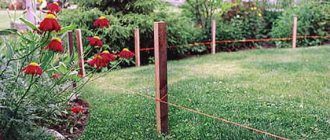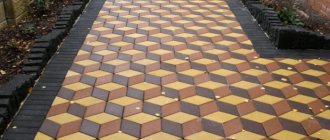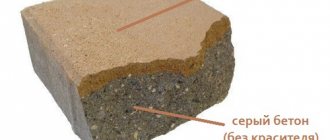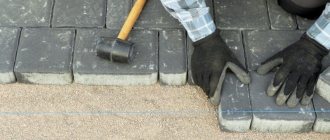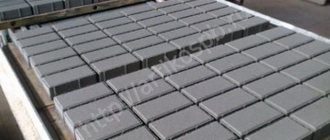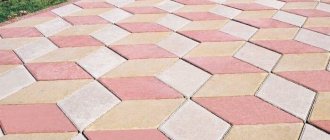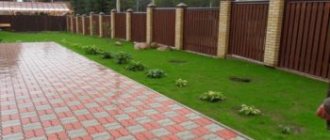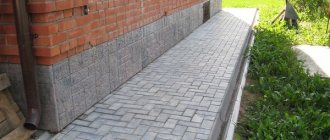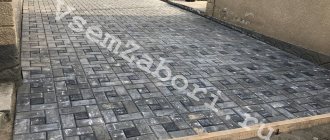2428
Brick paving slabs are among the most popular finishing materials. It is often used for paving paths for various purposes: in parks, in local areas, shopping areas. Due to sufficient strength characteristics, such a material is able to withstand quite high operational loads. A wide range allows you to create beautiful patterns. You just need to choose the appropriate scheme.
Brick is a popular material
Paving slabs and paving stones. Why is their thickness so important?
When we look at the cute tiled paths, we rarely think about what is underneath them, how thick/size are they? Meanwhile, there are special requirements for the thickness of the tiles, depending on the purpose. And if you don’t take this factor into account and buy the wrong size material just because you like a beautiful design, you run the risk of it quickly becoming unusable.
It must be taken into account that the durability and aesthetics of paved paths made of tiles and paving stones is determined not only by the type of layout, but also by the width and length of the blocks. However, the most important indicator is thickness.
According to this criterion, the following types of paving slabs are distinguished:
- for laying out pedestrian paths;
- universal;
- for paving surfaces with increased loads;
- for arrangement of monolithic sidewalks.
The scope of application is determined by the level of load for which a certain height of the tile layer is designed.
How to choose the right type of tile for your summer cottage? This is not difficult to do if you take a closer look at the differences and characteristics of this material.
What are the sizes of paving slabs and paving stones?
Paving slabs are loved by homeowners because of their high resistance to mechanical damage. Although they are inferior in this indicator to paving stones - they are somewhat thicker (higher in height), so the coatings made from them are more durable. Plus, it is generally accepted that paving stones look more beautiful, but they also cost more.
Let's look at the thickness of tiles for sidewalks, parking lots, and playgrounds:
- Paving blocks 3 cm thick . They are used for constructing garden and park paths and are among the most inexpensive. Often these versions are also in demand in personal plots, organizing parking spaces, barbecue areas under a canopy. It is also possible to lay thin tiles as steps near the entrance to the building. However, these elements are not recommended for entrance areas, since they are not intended for significant loads;
- Universal blocks 5-6 cm high . They are more expensive, but at the same time stronger and their scope of application is much wider. Thick paving stones can be used for arranging parking areas, as well as pedestrian paths with high traffic intensity. They are also recommended for laying on the floor in garages. Because these tiles are more durable, you won't have to worry about replacing them for years to come;
- Blocks for laying out monolithic coverings with a height of 7-8 cm . They have the highest price, but also the widest scope. Such paving stones can be used to construct driveways, parking lots, and driveways (including for trucks). These products are ideal for sidewalks with maximum loads and any operating conditions.
The optimal thickness for summer cottages and gardens is the range of 3-6 cm. This is the most economical, but at the same time, practical and versatile block format. However, in case of expected high loads and high intensity of use, it is better to consider thicker tiles.
Advantages and disadvantages
Paving stones are made by pouring them into standard forms, so the process of laying them is greatly simplified. In addition, components can be added to the composition for the production of tiles that affect its quality, wear resistance and other performance characteristics.
The advantages of this material over others include:
- variety of shapes, colors, textures;
- resistance to temperature fluctuations, humidity, loads in the presence of a wear-resistant corrugated coating;
- simplicity of installation and ease of installation work, including water supply and sewerage systems. Possibility of replacing one or more fragments if damaged, repeated use with environmental safety.
Paving slabs have the following disadvantages:
- careful preparation of a leveled plane for laying, with the creation of a sufficiently large layer of sand cushion (especially on heaving soils and areas with high groundwater levels, including seasonal rise);
- moisture entering the pores of the material crystallizes when frost occurs and increases in volume, thereby destroying the tile from the inside, which affects its service life;
- Additional filling of joints is required, since the material between the tiles periodically sags, and it is necessary to remove rooting plants.
With all its advantages and disadvantages, sidewalks still remain one of the most popular paving materials. And thanks to the diversity, you can choose options with a minimum of disadvantages.
Paving slabs and paving stones. Variety of forms
The size of the tile also determines its consumption. Depending on its length and width, experts calculate the number of blocks required to create a path or area of the required size.
Today there are hundreds of options for tiles and paving stones on the market, all of them differ in their sizes. Although, in this market, there are some standards. Let's look at them in more detail:
- Square , with identical edges 30x30, 35x35 or 40x40 cm. Larger blocks (50x50 cm in size and above) are rarely used in summer cottages. They are mainly used for paving large areas with tiles;
- Rectangular . They resemble a brick in shape. As a rule, they have side dimensions of 20x10 and 25x12.5 cm. Although other formats may come across;
- Figured blocks are available in various lengths and widths. The most common sizes of paving slabs are: 20x16, 12x18, 12x19 cm, and equilateral 29.5x29.5x29.5 cm.
All types of tiles are suitable for arranging garden paths. However, if you are planning to buy paving stones for paving a parking lot or driveway, it is better to choose blocks of greater thickness and small size. As practice has shown, such surfaces are more durable under high loads.
Thin tiles and features of their use
We should also consider ultra-thin paving slabs, up to 2 cm thick. These blocks are also often used in landscaping summer cottages, due to a number of unique advantages:
- they look very neat;
- tolerate frost well;
- more resistant to fading in the sun;
- they do not require digging out a large layer of soil;
- they are easy to replace with new ones;
- they are highly durable (up to 15 years) and are cheaper.
However, it is not possible to lay thin tiles or paving stones everywhere. This is due to the rapid wear of the material under increased loads. Such paving blocks are usually used for landscape design, to create decorative garden paths, or small barbecue areas.
When choosing thin tiles, you must take into account what components it is made of, who and how it was produced, the type and method of painting, i.e., everything that can affect the strength of the product. As a rule, such tiles contain: concrete, rubber, porcelain stoneware, polymer-sand mixture, and they are produced either by vibration casting or stamping.
Another undoubted advantage of thin paving stones is the ease of working with them. It is light in weight and small in size, and you don’t have to dig deep into the soil—it’s quite possible to lay such paving slabs yourself, without involving construction crews. To lay such tiles, it is enough to dig out the soil only 1.5 cm, then level the surface and make a sand cushion or a base of crushed stone.
You can learn more about all the intricacies of laying this material, as well as choose paving slabs on the website: https://trotuar-moskow.ru/.
About brick tiles
Paving stones are a shaped product used for paving paths. For its manufacture, refractory clay and vida are used. Subsequent firing not only ensures high performance characteristics of the finished brick, but also gives it a unique appearance. The same batch may contain products with different colors, which is very popular in landscape design.
Color may not be uniform
The main advantages of clinker bricks include:
- Wear resistance. It is able to withstand a fairly large operating load, while remaining resistant to abrasion and possible damage;
- Frost resistance. In case of heavy snowfall and low temperatures, brick tiles do not deform or crack;
- Durability. Laying brick paving slabs is important. If the technology is not broken, the formed coating can last for decades without changing its original appearance;
- Resistance to chemicals;
- Non-toxic. Possible installation near residential premises;
- Reusable. If necessary, paving slabs can be dismantled and then re-laid. This is especially true if communications are laid under the path. If it is necessary to replace pipes or perform other types of repair work, the tiles are first dismantled and then laid again.
Not afraid of moisture
Attention! Manufacturers offer various types of material, which allows you to beautifully design a site of any shape and size.
Which to choose?
Having decided to lay out an original ornament from paving slabs, you should carefully consider the choice of the purchased material. Products differ in:
- Size. In this case, you must take into account the intended purpose of the purchased material. The thicker the material, the greater the load the track can withstand. Standard thickness 60 mm. Quite often, paving stones 200x100x60 are used, which can withstand heavy loads. The weight of paving slabs is not so important. Provided that we are not talking about decorating the bridge;
- Form. It is not necessary to purchase a classic rectangular product. In manufacturers' catalogs you can find figured and lattice tiles.;
- Blossom. In addition to the standard brick-red, you can become the owner of white, gray or purple brick;
- Invoice. You can purchase tiles with a smooth or rough surface that imitate stone.
Color may vary
Advice! To achieve the best result, it is worth using products of different sizes, colors and textures to decorate the area. The main thing is that the material is of high quality and has an impeccable appearance.

